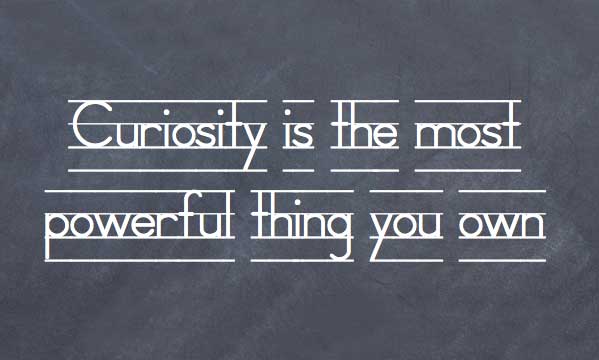
It’s curious how little is really articulated about the need for curiosity. Aristotle claimed that the desire to know is a basic human drive. We recognize the power in knowledge, but we give little heed to the force that drives us to learn. Curiosity is a compelling faculty that aids us to nudge the given, push the boundaries of our assumptions, and create new understanding.
There is a part in almost all of us that yearns for the child-like curiosity we all once shared. “Why is the sky blue?” “What makes the leaves turn green?” As adolescents we thought a lot about the birds and the bees, or how to parallel park a car. Even when we first entered the workforce, so many of us were curious as to how we could make a difference. So why has one of the most basic instincts been so muzzled in the lives of so many? No one clear answer comes to mind, but somewhere between K through 12th grade, and if not then, between our very first paycheck and the timesheet we submitted last week, too many of us have shelved that part of us that is truly curious.
An example of how curiosity fails in a variety of ways came to me while providing professional development programs for the Walt Disney World Company. Since Disneyland opened in 1955, the parks have always dealt with long lines of people. Over time, Disney made itself the master of the queue. Walking in the footsteps of its guests, Disney constantly asked the question, “How can we handle long lines?” Answers came in the form of efficient ride vehicles, to frequent switchbacks, from announced wait times to outdoor air conditioning, from theming the line to entertaining guests as they waited. Every possible idea was explored to make the least satisfactory part of a day at the park more tolerable.

Still, for all those dozens of years, no one ever asked, “Why don’t we get rid of the line?” That is, until recently, when the parks came out with FastPass, a software program that spit out passes to guests, giving them the option of coming back later, but being able to walk to the front of the line. The results were terrific—not only did the parks have happier visitors, but those same customers chose to spend much of their free time in shopping and dining experiences, creating a greater per cap return.
Of course, such software hasn’t been available since 1955. But the computational capabilities to monitor numbers, and then compute waiting times has been around for quite some time, simply waiting for someone to have written the particular set of algorithms. Embarrassingly, it was a no-name amusement park in the U.K. that had attempted it before Disney made any efforts. And the concept of providing return times on its tram tour has been at Universal Studios Hollywood for several decades. With all of its management, why didn’t somebody sooner explore: “Can we get rid of the line?”
Even stranger—go to a Disney park and observe. Use FastPass yourself, and when you come back later to walk on the ride, consider why is it that you pass by hundreds of other Guests who, despite huge promotional efforts, still choose to wait in the stand-by line in a wait that can easily exceed 75-90 minutes? Surely one would be a bit more curious standing there watching others walk right in front of them to the front of the line.
In part 2 we discuss why we aren’t more curious.

15 thoughts on “The Art of Curiosity”
Comments are closed.